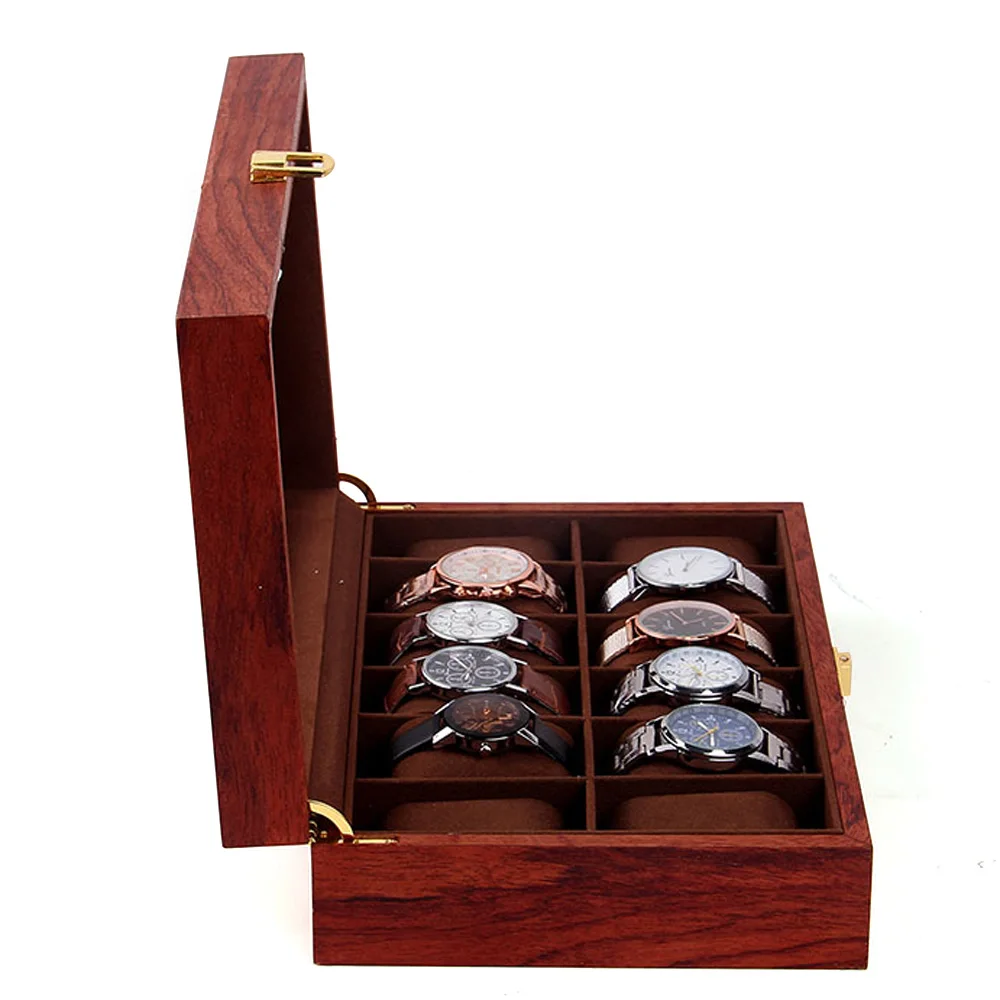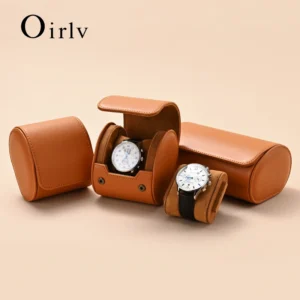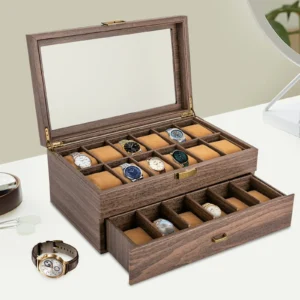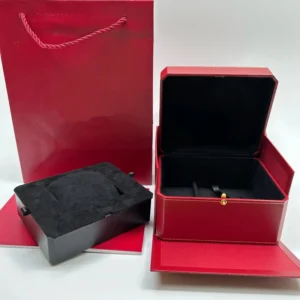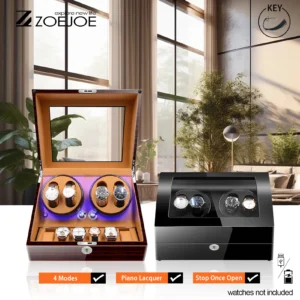Understanding What Makes Wood Ideal for Watch Boxes
When it comes to storing and displaying fine timepieces, wooden watch boxes have long been the gold standard among collectors and enthusiasts. The relationship between wood quality and watch preservation is not merely aesthetic—it’s fundamental to protecting your valuable timepieces for years to come.
Wood offers natural properties that make it uniquely suited for watch storage. Its organic structure provides natural insulation against temperature fluctuations that can damage delicate watch mechanisms. Additionally, quality hardwoods help regulate humidity at the ideal levels (45-60%) for timepiece preservation, creating a stable environment that metal or plastic containers simply cannot match.
The best wood for watch boxes serves dual purposes: protection and presentation. The right wood not only shields your watches from environmental factors but also showcases them with natural elegance that enhances their beauty. Much like the craftsmanship that goes into a fine watch, the selection of wood for its storage requires careful consideration of multiple factors.
At Daily Accents, the selection process for wooden watch boxes involves rigorous evaluation of various wood species. Each type offers different characteristics in terms of stability, appearance, and protective qualities. Throughout history, prestigious watchmakers have favored certain woods for their display cases—a tradition that continues in today’s premium wooden watch box collections.
As we explore the world of watch box woods, you’ll discover why certain varieties stand above others and how to select the perfect match for your timepiece collection.
Critical Factors in Selecting the Best Wood for Watch Boxes
When evaluating the best wood for watch boxes, several key factors determine both functionality and longevity. Understanding these characteristics helps collectors make informed decisions that balance protection, aesthetics, and value.
Durability and Hardness
The durability of a watch box directly affects how well it protects your timepieces. Hardness is measured using the Janka hardness scale, which indicates a wood’s resistance to denting and wear. Woods with higher Janka ratings offer superior protection against physical damage.
Hardwoods typically outperform softwoods in this category, providing better resistance to scratches and impacts that might occur during handling or transportation. This protection is crucial when storing valuable watches that may be passed down for generations.
The structural integrity of harder woods also ensures the box maintains precise alignment of hinges, dividers, and closures—details that directly affect how securely your watches are held in place.
Stability and Humidity Regulation
Wood’s natural cellular structure makes it an excellent material for regulating humidity—a critical factor in preserving watches. The best woods for watch boxes demonstrate dimensional stability, meaning they resist warping, swelling, or shrinking with humidity changes.
Properly kiln-dried wood significantly reduces the risk of future warping that could potentially damage watches or compromise the box’s protective seal. Some woods naturally excel at maintaining consistent internal conditions, creating a stable microenvironment that shields watches from potentially harmful humidity fluctuations.
Aesthetics and Grain Patterns
While protection is paramount, the visual appeal of a watch box enhances the collecting experience. Different woods offer distinct grain patterns, colors, and characteristics that may complement various watch styles.
Some woods develop a beautiful patina over time, becoming more attractive with age and use. Others maintain their original appearance with minimal change, providing a consistent presentation for decades. The aesthetic quality should harmonize with your collection, whether you prefer contemporary, classic, or vintage timepieces.
Chemical Neutrality
The chemical composition of wood can significantly impact its suitability for watch storage. Some woods contain natural oils and acids that could potentially interact with metal components in watches over extended periods.
The materials used in quality watch boxes should be chemically neutral to prevent any reactions with watch metals or finishes. This is particularly important for long-term storage of valuable timepieces, as even slight chemical interactions could affect a watch’s appearance or function over time.
The benefits of proper wooden watch storage extend beyond mere organization—they include protection from environmental factors, security from physical damage, and preservation of value through proper display and care.
Premium Hardwoods: The Gold Standard for Watch Boxes
When it comes to the finest watch boxes, certain premium hardwoods consistently stand out for their exceptional qualities. These woods represent the pinnacle of both protective functionality and aesthetic appeal.
Walnut (American Black Walnut)
American Black Walnut has earned its reputation as one of the most desirable woods for high-end watch boxes. Its rich chocolate-brown color ranges from deep, coffee-like tones to lighter hues with subtle purple undertones, all showcasing straight grain patterns with occasional gentle waves.
Advantages:
– Exceptional stability in varying humidity conditions
– Outstanding shock absorption properties to protect delicate movements
– Develops a richer color and lustrous patina with age
– Dense enough to provide excellent protection without excessive weight
– Naturally resistant to warping and cracking
Disadvantages:
– Higher cost compared to many other hardwoods
– Somewhat heavier than some alternative options
– May darken significantly over time, changing its original appearance
Walnut’s combination of stability, beauty, and protective qualities makes it particularly well-suited for collectors with valuable timepieces requiring long-term storage.
Mahogany
With its distinctive reddish-brown coloration and interlocking grain pattern, mahogany has been prized in fine furniture making for centuries. This tradition extends to premium watch boxes, where its properties offer both beauty and functionality.
Advantages:
– Remarkable stability, even in humid environments
– Ideal balance of hardness and workability for detailed craftsmanship
– Exceptional dimensional stability prevents warping
– Rich color that deepens attractively with age
– Excellent resistance to rot and decay
Disadvantages:
– Genuine mahogany has become increasingly scarce and expensive
– Requires careful sourcing to ensure sustainability
– Some varieties are more susceptible to scratching than other premium options
Mahogany’s historical significance and proven track record in fine furniture construction make it an excellent choice for collectors who appreciate traditional craftsmanship.
Cherry
American Cherry wood offers a warm, inviting appearance with its reddish-brown hue that naturally darkens and richens with exposure to light. Its straight, fine grain provides a smooth, uniform appearance that many collectors find appealing.
Advantages:
– Develops a beautiful rich patina over time
– Excellent workability allows for precise detailing
– Good dimensional stability once properly dried
– Moderate hardness provides adequate protection
– Warm, inviting appearance that complements most watch styles
Disadvantages:
– More photosensitive than other woods, requiring consideration of box placement
– Somewhat softer than walnut or maple, potentially more susceptible to denting
– Color can change significantly over time, which may or may not be desirable
Cherry represents an excellent option for collectors who appreciate how wood changes and improves with age, developing character that parallels the aging process of fine watches themselves.
These premium hardwoods form the foundation of many luxury watch box collections, offering the highest levels of protection and presentation for fine timepieces.
Mid-Range Hardwoods: Excellent Performance with Value
While premium hardwoods offer outstanding quality, several mid-range options provide excellent performance at more accessible price points. These woods strike an appealing balance between quality, durability, and cost.
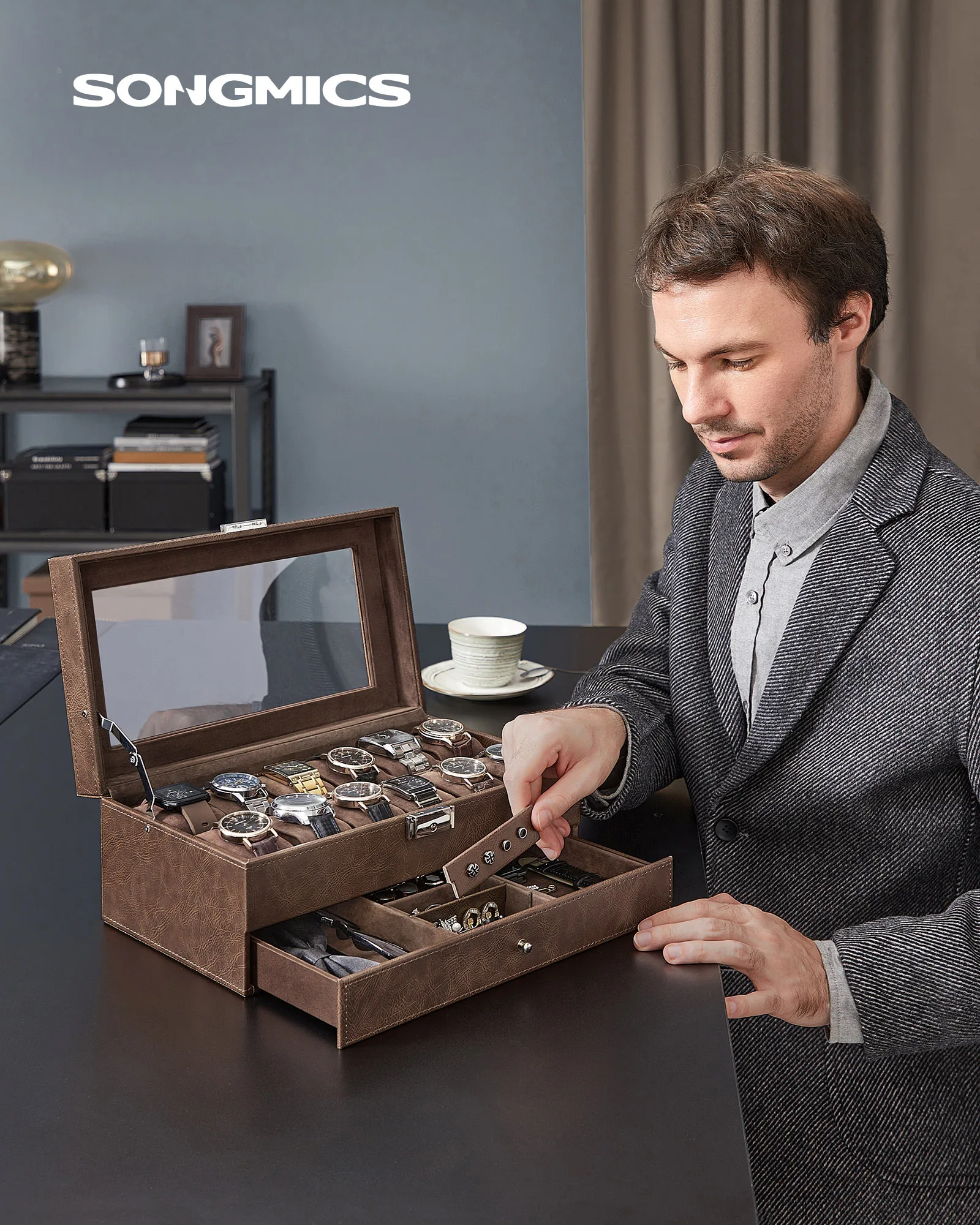
Oak (Red and White)
Oak has been trusted for centuries for its remarkable durability and distinctive grain pattern. Both red and white varieties offer excellent protective properties, though they differ slightly in characteristics.
Red Oak:
– Slightly reddish undertones with prominent, open grain patterns
– Very good durability with moderate resistance to moisture
– Excellent availability and consistent quality
– Accepts stains and finishes evenly for varied appearances
White Oak:
– More golden-brown tones with tighter grain structure
– Superior moisture resistance compared to red oak
– Exceptional durability and stability once properly dried
– Contains natural compounds that can occasionally interact with metals (requiring proper interior lining)
Oak’s legendary toughness and widespread availability make it a practical choice for watch collectors seeking long-term durability without premium pricing.
Maple (Hard Maple)
Hard maple (also called sugar maple) presents a clean, light appearance with a tight, uniform grain structure. Its pale cream to light reddish-brown color provides a bright, contemporary aesthetic.
Key Characteristics:
– Exceptional hardness and wear resistance
– Very tight grain minimizes moisture absorption
– Contemporary appearance that works well in modern settings
– Special figured varieties (bird’s-eye, curly, quilted) offer unique visual interest
– Excellent stability when properly dried
Maple’s combination of hardness and clean appearance makes it particularly suitable for collectors who prefer contemporary design aesthetics or who have modern watch collections.
Acacia
Growing in popularity for furniture and decorative items, acacia wood offers stunning grain patterns and rich color variations ranging from golden brown to deeper chocolate tones.
Key Characteristics:
– Remarkable durability with good hardness ratings
– Distinctive, often dramatic grain patterns
– Excellent sustainability credentials due to rapid growth
– Very good natural resistance to moisture and warping
– Rich color variations provide unique character
The sustainable nature and visual interest of acacia make it an increasingly popular choice for wood and leather watch boxes that combine environmental consciousness with striking aesthetics.
Sheesham (Indian Rosewood)
Sometimes marketed as Indian Rosewood, Sheesham features rich golden to deep reddish-brown coloration with distinctive darker streaking and grain patterns.
Key Characteristics:
– Dense structure provides excellent durability
– Natural oils offer good moisture resistance
– Distinctive grain patterns create visual interest
– Natural resistance to insects and decay
– Strong yet workable for detailed craftsmanship
Sheesham’s combination of durability, distinctive appearance, and moderate pricing has made it increasingly popular for crafted watch boxes in the mid-range market.
Exotic and Specialty Woods for Distinctive Watch Boxes
For collectors seeking truly unique or statement pieces, exotic and specialty woods offer unparalleled visual impact. These less common options often feature in high-end, limited-edition, or custom watch boxes.
Ebony
True ebony is among the densest and darkest woods available, prized for its deep black coloration and exceptional hardness. This remarkable wood has been used for luxury items for centuries.
Key Characteristics:
– Extraordinarily dense and heavy structure
– Deep black or dark brown coloration
– Exceptionally smooth finish when properly worked
– Remarkable dimensional stability once dried
– Often used as an accent rather than primary material due to cost and sustainability
Due to rarity and sustainability concerns, ebony is typically reserved for accents, inlays, or ultra-luxury watch boxes rather than full construction.
Burl Woods (Amboyna, Thuya, etc.)
Burls are abnormal growths on trees that create spectacularly swirling, complex grain patterns unlike any other wood. Various tree species produce these rare formations, with each having distinctive characteristics.
Key Characteristics:
– Extraordinarily intricate, swirling grain patterns
– Unique appearance that makes each piece one-of-a-kind
– Typically used as veneers due to structural irregularities and cost
– Range of colors from golden brown to rich reddish tones
– Premium pricing reflecting extreme rarity
Burl woods typically appear as decorative veneers on box lids or panels, providing dramatic visual impact while more stable woods form the structural components.
Bamboo (Engineered)
While technically a grass rather than a wood, engineered bamboo has gained popularity as a sustainable alternative for watch boxes.
Key Characteristics:
– Exceptional sustainability credentials (rapid renewability)
– Contemporary, distinctive appearance
– Good stability when properly engineered
– Moderate durability suitable for everyday use
– Appealing to environmentally conscious collectors
Bamboo’s unique combination of sustainability and distinctive appearance makes it an interesting alternative for best materials in watch storage solutions with environmental considerations.
The Importance of Interior Materials and Construction
While selecting the right wood is essential, the interior materials and construction quality are equally critical for proper watch protection.
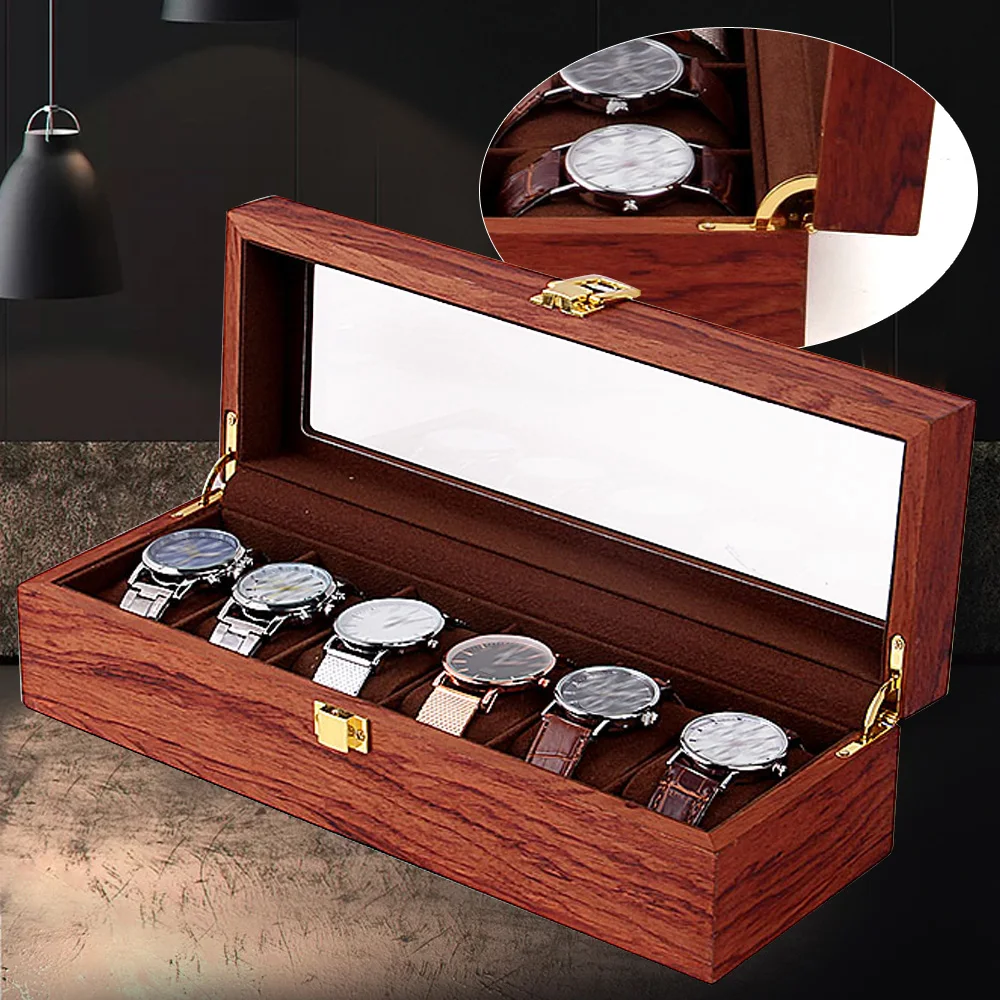
Interior Lining Materials
The interior lining of a watch box comes into direct contact with your timepieces, making its quality and composition crucial:
- Velvet: Offers luxurious softness and excellent scratch protection, though may collect dust over time
- Suede: Provides a secure grip that prevents watches from sliding while offering good protection
- Microfiber: Delivers outstanding scratch resistance with minimal dust accumulation
- Linen: Creates a clean, breathable environment with subtle texture
The color of the lining not only affects aesthetics but also visibility—darker linings often showcase lighter-colored watches better, while lighter linings highlight watches with dark dials or straps.
Construction Quality
Superior wood is only beneficial when matched with excellent construction techniques:
- Joinery Methods: Quality boxes feature precision joinery like dovetail or finger joints rather than simple butt joints with glue
- Hinges and Hardware: Solid brass or stainless steel hardware ensures smooth, reliable operation for years
- Finishing Process: Proper sanding, sealing, and finishing protect the wood while enhancing its natural beauty
- Interior Dividers: Well-fitted, padded dividers prevent watches from contacting each other
These construction elements directly impact both the protective qualities and longevity of watch and jewelry boxes, making them crucial considerations alongside wood selection.
How to Choose the Perfect Wood for Your Watch Collection
Selecting the ideal wood for your watch box involves balancing several personal factors beyond just the wood characteristics themselves.
Based on Budget
Different price points offer varying options without necessarily compromising essential protection:
- Premium Tier ($200+): Walnut, mahogany, cherry, and exotic accents offer the highest quality in both materials and craftsmanship
- Mid-Range ($100-200): Oak, maple, and acacia provide excellent durability and appearance at more moderate prices
- Entry-Level ($50-100): Quality-engineered woods with proper finishes can still provide good protection while being budget-friendly
When considering budget, prioritize construction quality and interior lining over wood species if faced with trade-offs.
Based on Aesthetic Preference
Different wood types naturally complement various watch collections:
- Traditional/Classic: Mahogany and walnut complement vintage watches and dress watches with their rich, warm tones
- Contemporary/Modern: Maple and lighter-finished woods pair beautifully with modern sport and tool watches
- Distinctive/Unique: Burl woods or exotic species create statement pieces for collectors who value unique presentation
Consider how the wood’s color, grain, and character will enhance your specific collection’s appearance.
Based on Collection Size and Value
Your collection’s characteristics should influence your wood selection:
- Valuable Heritage Collections: Premium hardwoods with proven stability offer the best long-term protection for significant investments
- Growing Collections: Consider modular options or woods that age well as your collection evolves
- Mixed Collections: Versatile woods with neutral tones complement diverse watch styles
Understanding the differences between wood and leather watch cases can also help determine which material better serves your specific collection needs. For collections of exceptional value, prioritizing safe watch storage protection means selecting woods with proven stability and protective qualities.
Luxury Watch Boxes, Men's Watch Boxes, Single Watch Box
Price range: $903.35 through $980.97 Select options This product has multiple variants. The options may be chosen on the product pageSingle Watch Travel Case, Watch and Jewelry Box, Watch Roll Travel Case
Price range: $93.44 through $140.65 Select options This product has multiple variants. The options may be chosen on the product pageMen's Watch Organizer, Watch Display Case, Watch Organizer
Price range: $112.68 through $169.45 Select options This product has multiple variants. The options may be chosen on the product pageAutomatic Watch Winder, Luxury Watch Winder, Single Watch Box
$307.39 Select options This product has multiple variants. The options may be chosen on the product pageLuxury Watch Boxes, Luxury Watch Travel Case
Price range: $200.33 through $224.57 Select options This product has multiple variants. The options may be chosen on the product page4 Watch Winder, 6 Watch Box, Automatic Watch Winder
$512.31 Select options This product has multiple variants. The options may be chosen on the product page
Long-term Care for Wooden Watch Boxes
To maintain your wooden watch box’s beauty and functionality for years to come, proper care is essential.
Cleaning and Maintenance
Regular but gentle maintenance preserves both appearance and function:
- Dust exterior surfaces weekly with a soft, lint-free cloth
- Clean fingerprints or smudges with a very slightly dampened cloth, followed immediately by drying
- Use appropriate wood conditioners sparingly (once or twice yearly) to maintain moisture balance
- Avoid silicone-based polishes that can build up and affect wood’s natural breathing properties
- Clean interior linings with a soft brush vacuum attachment rather than liquids
Environmental Considerations
Proper placement significantly impacts wood longevity:
- Position watch boxes away from direct sunlight to prevent fading and potential warping
- Maintain reasonable room humidity (40-60%) to support wood’s natural stability
- Keep boxes away from heating vents, radiators, and air conditioning outlets that create localized humidity fluctuations
- Consider using humidity control elements in extremely dry or humid environments
With proper care, a quality wooden watch box can maintain its beauty and functionality for generations, making it a fitting home for fine timepieces. For long-term display options, consider watch display cases that showcase your collection while maintaining proper protection.
Understanding Wood Finishes and Their Impact on Watch Storage
The finish applied to a wooden watch box serves both decorative and protective functions, significantly affecting how the wood interacts with your watches and environment.
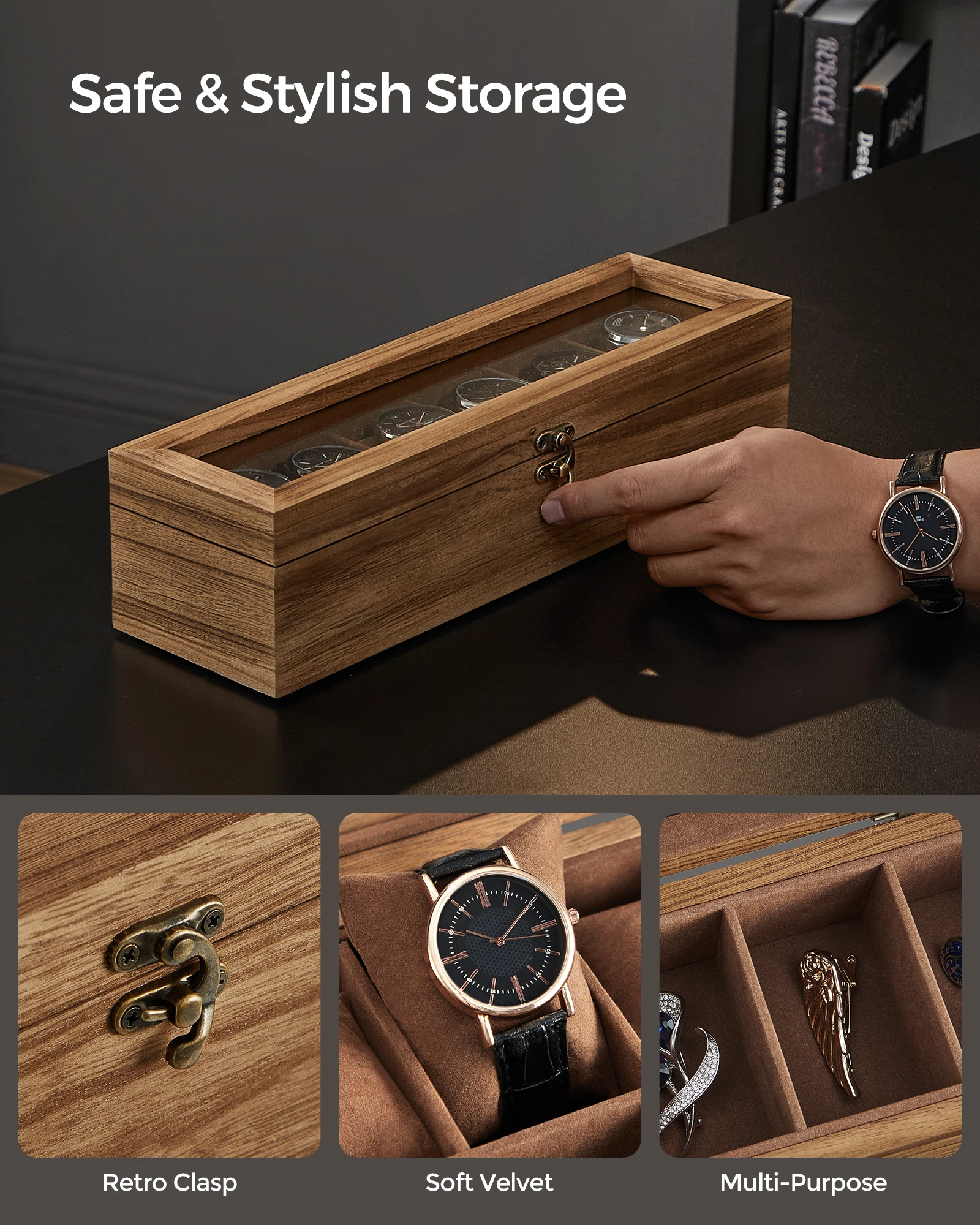
Types of Wood Finishes
Different finishes offer varying levels of protection and aesthetic effects:
Oil-Based Finishes: Penetrate wood fibers, enhancing grain while allowing the wood to “breathe” and adjust to humidity changes naturally. These produce a warm, natural appearance but offer less moisture protection.
Lacquer Finishes: Create a hard, protective surface that excels at moisture resistance. Modern water-based lacquers provide excellent protection with minimal odor and lower environmental impact.
Shellac: A traditional natural finish that creates a warm amber tone. It offers moderate moisture protection while allowing the wood to maintain some of its natural breathing properties.
Polyurethane: Provides maximum durability and moisture protection but creates a more plastic-like surface that completely seals the wood. Best for high-use environments but may affect the wood’s natural moisture exchange properties.
The choice of finish affects both how the wood ages and how effectively it regulates internal humidity, making it an important consideration when selecting a watch box. Understanding proper maintenance requirements for wood cases ensures you can preserve your watch box’s finish for years to come.
Common Questions About Wood and Watch Preservation
Many collectors share similar questions about how wood interacts with their precious timepieces.
Will wooden watch boxes scratch my watches?
Quality wooden watch boxes should include proper interior lining materials like velvet, suede, or microfiber specifically designed to protect watch surfaces. The wood itself should never come into direct contact with your timepieces.
What is “quarter-sawn” wood and why is it desirable for watch boxes?
Quarter-sawn refers to how lumber is cut from the log, resulting in grain patterns that run perpendicular to the board’s face. This cutting method creates significantly greater dimensional stability, reducing warping and movement with humidity changes—ideal qualities for watch storage.
Are solid wood boxes superior to wood veneer boxes?
Not necessarily. High-quality veneer construction often provides better stability than solid wood because it uses cross-banded layers that resist warping. Premium watch boxes often combine solid wood frames with veneer panels to maximize both stability and beauty.
Which woods are most susceptible to humidity changes?
Oak, particularly red oak, has a more open grain structure that makes it more responsive to humidity fluctuations. Other woods like cherry and maple fall in the middle range, while closed-grain woods like walnut and mahogany tend to be more stable in varying conditions.
The Sustainable Choice: Eco-Friendly Wood Options
As environmental awareness grows, many collectors are considering sustainability alongside quality and aesthetics when selecting watch boxes.
Forest Stewardship Council (FSC) certification ensures wood comes from responsibly managed forests that provide environmental, social, and economic benefits. Look for this certification when prioritizing sustainable options.
Bamboo stands out as a rapidly renewable resource, reaching harvest maturity in 3-5 years compared to decades for hardwoods. Modern manufacturing techniques have improved bamboo’s durability and appearance, making it increasingly viable for quality watch storage.
Reclaimed woods repurpose timber from old buildings, furniture, or fallen trees, giving new life to existing materials. While requiring careful processing to ensure stability, these woods offer unique character and history alongside environmental benefits.
For collectors seeking both quality and environmental consciousness, these sustainable options provide attractive alternatives without compromising on the essential protective qualities needed for proper watch box storage.

